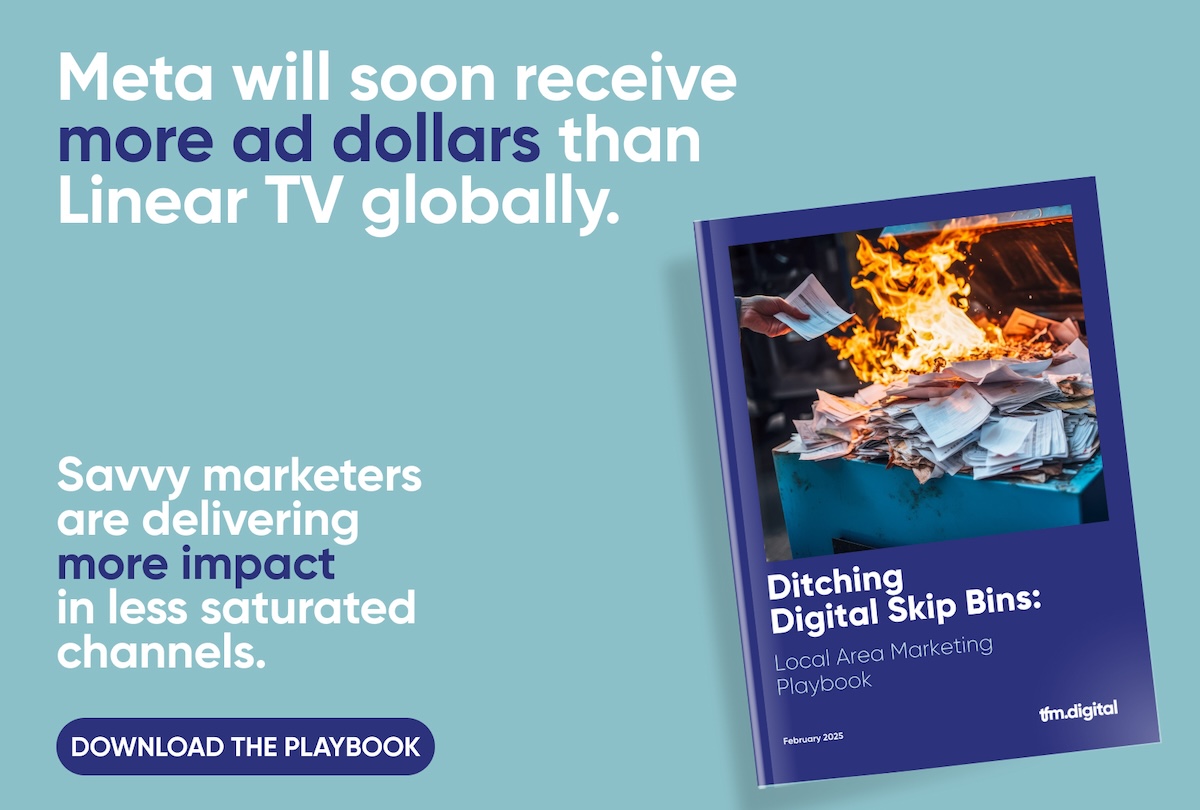TFM Digital’s new ‘Ditching Digital Skip Bins’ report finds brands are shifting local area marketing budgets away from Google/Meta

TFM Digital has released a new report, which has found that brand budgets are starting to look for results outside of Meta/Google for their local area marketing efforts.
Meta has been in the headlines at the beginning of this year for all the wrong reasons with an end to its third-party fact-checking program. It’s resulted in a spike in users searching Google to delete both Facebook and Instagram. The move has raised ongoing concerns for the spread of misinformation along with brand safety issues for advertisers.
While Facebook ad revenues are set to overtake linear TV in 2025, many marketers now claim the platform has reached saturation point and is no longer delivering the results they expect.
Through the scale and competition on these platforms, Meta and Google have created ‘digital skipbins’, like the letter box drops of old, where business owners are not getting what they need. An overreliance on automation is being blamed.
“Business owners are not marketers or media planners and buyers,” begins Kelly Healy, GM Advertising Sales QLD/SA/WA at News Corp, “…they need guidance to be interrogating these campaigns – what is the best solution for the outcome I’m trying to achieve.”
The rise in tech platforms, prioritising profits over user and advertiser experience saw the pattern of enshittification named Macquarie Dictionary’s word of the year in 2024. This drop in quality of experience and results for local area marketers has been paired with a rise in price for diminishing returns. Meta’s reported cost per ad across its platform has risen 14% year-over-year, resulting in the 90% SMBs in Australia using Facebook for their business dealing with CPMs around 10.31% higher on Facebook and Instagram than 2 years ago according to research in the report (based on TFM’s actual CPM costs for clients over that period).
Commenting on the experience for Price Attack, CMO Aimee Madson, said: “We had an experience on one channel, where our costs tripled and our results weren’t there. Times are tough. Retail is tough. So we have looked elsewhere – we can’t afford to waste money on a platform that doesn’t seem consistent anymore.”
The report goes on to offer an action plan for brands looking to ensure their LAM efforts are more effective, including improving mental availability, nuances of delivering local impact, making your campaign fit for purpose and the role of personalisation.
When speaking about delivering the right message Telstra’s Senior Marketing Specialist, Anjela Gilbert said: “Our aim is always to hypertarget local areas to drive traffic into stores. We’re more than happy for them to educate people online, but we know that customers are more likely to purchase in-store. So that’s the job of our LAM. Drive traffic to where we can best convert.”
Author of the report, and TFM CEO, Taylor Fielding explains: “We wanted to dig into the complex topic of Local Area Marketing (LAM) and simplify the space for marketers. Doing more with less is no longer the end to a corporate speech, but a mantra that all must live by. LAM is often placed in the too hard bucket.
“Indeed automation and efforts to become more efficient have led to marketing principles of measurement and effectiveness being sidelined for easy to deploy ‘cookiecutter’ personalisation tools. While automation platforms provide unparalleled access to information, when all rely on the same platforms, with the replica personas, differentiation becomes a distant hope; in essence all of our efforts become a darker shade of AI.
“So against the backdrop of a fragmented digital landscape, with dwindling attention thanks to an over exposure of online ads, we investigate how marketers can shift their mindset and approach to make LAM more effective.”
Indie agency TFM Digital, recently listed in the AFR’s Fast100, also counts AusBuild, Poolwerx, Eureka Furniture and Goodstart Early Learning among its client roster.
Download a copy of the report here.
